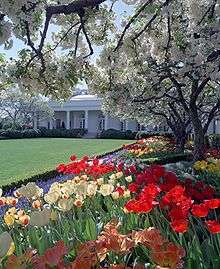White House Rose Garden

The White House Rose Garden is a garden bordering the Oval Office and the West Wing of the White House in Washington, DC, United States. The garden is approximately 125 feet long and 60 feet wide (38 meters by 18 meters). It balances the Jacqueline Kennedy Garden on the east side of the White House Complex.
Design and horticulture
The White House Rose Garden was established in 1913 by Ellen Loise Axson Wilson, wife of Woodrow Wilson, on the site of a previous colonial garden established by First Lady Edith Roosevelt (wife of Theodore Roosevelt) in 1902.[1] Prior to 1902, there were extensive stables, housing horses and coaches, located on the grounds of the present-day Oval Office, Cabinet Room, and Rose Garden. During the 1902 Roosevelt renovation, First Lady Edith Roosevelt insisted on a proper colonial garden to help replace the conservatory rose house that had stood here. In 1961, during the John F. Kennedy administration, the garden was redesigned by Rachel Lambert Mellon. Mellon created a space with a more defined central lawn, bordered by flower beds planted in a French style, but largely using American botanical specimens. The present garden follows a layout established by Mellon. Each flower bed is planted with a series of 'Katherine' crabapples and Littleleaf lindens bordered by a low diamond-shaped hedges of thyme. The outer edge of the flower bed facing the central lawn is edged with boxwood. The four corners of the garden are punctuated by Magnolia × soulangeana; these specimens were found growing along the Tidal Basin by Mellon. Roses are the primary flowering plants in the garden and include large numbers of "Queen Elizabeth" grandiflora roses, and the tea roses "Pascale," "Pat Nixon," and "King's Ransom." A shrub rose, "Nevada Rose" adds a cool note of white. Seasonal flowers are interspersed to add nearly year-round color. Spring blooming bulbs planted in the rose garden include jonquil, daffodil, fritillaria, grape hyacinth, tulips, chionodoxa and squill. Summer blooming annuals change yearly. In the fall chrysanthemum and flowering kale bring color until early winter. Every summer on July 1, garden gnomes are placed in the Rose Garden. The number represents the number of living presidents at the present time.
Official and informal use

Beginning with the establishment of the garden in the early twentieth century the Rose Garden has been used for events. President Wilson met there with the press for informal questions. President Hoover began a tradition of welcoming and being photographed with prominent citizens there. Calvin Coolidge used the garden for making public announcements about policy and staffing decisions. President John F. Kennedy welcomed Project Mercury astronauts in the garden. Many presidential news conferences take place in the garden, as well as occasional White House dinners and ceremonies. The marriage of President Richard Nixon's daughter Tricia to Edward F. Cox took place in the Rose Garden in 1971. In recent years, joint news conferences with the president and a visiting head of state have been held in the Rose Garden. Presidents frequently host American Olympic and major league athletes in the Rose Garden after winning in their respective sport. George W. Bush welcomed the Stanley Cup champion Carolina Hurricanes to the Rose Garden after their victory in 2006.
The phrase "Rose Garden strategy" (such as a re-election strategy) refers to staying inside or on the grounds of the White House as opposed to travelling throughout the country.[2] For example, Jimmy Carter's initial efforts to end the Iran hostage crisis (1979–1981) were a Rose Garden strategy because he mostly held discussions with his close advisers in the White House. On July 25, 1994 a declaration of peace between Israel and Jordan was signed in the Rose Garden.
Although the Rose Garden is used frequently to greet distinguished visitors and for special ceremonies and public statements, the contemplative setting is often a very personal and private place for the President. In 1935, President Franklin D. Roosevelt commissioned Frederick Law Olmsted, Jr. to redesign the gardens, and he installed cast iron furniture pieces.
See also
References
- ↑ "The Rose Garden". White House Museum. Retrieved 9 November 2015.
- ↑ http://politicaldictionary.com/words/rose-garden-campaign/
Further reading
- The White House: An Historic Guide. White House Historical Association and the National Geographic Society: 2001. ISBN 0-912308-79-6.
- Abbott James A., and Elaine M. Rice. Designing Camelot: The Kennedy White House Restoration. Van Nostrand Reinhold: 1998. ISBN 0-442-02532-7.
- Clinton, Hillary Rodham. An Invitation to the White House: At Home with History. Simon & Schuster: 2000. ISBN 0-684-85799-5.
- Garrett, Wendell. Our Changing White House. Northeastern University Press: 1995. ISBN 1-55553-222-5.
- McEwan, Barbara. White House Landscapes. Walker and Company: 1992. ISBN 0-8027-1192-8.
- Mellon, Rachel Lambert. The White House Gardens Concepts and Design of the Rose Garden. Great American Editions Ltd.: 1973.
- Seale, William. The President's House. White House Historical Association and the National Geographic Society: 1986. ISBN 0-912308-28-1.
- Seale, William. The White House Garden. White House Historical Association and the National Geographic Society: 1996. ISBN 0-912308-69-9.
External links
| Wikimedia Commons has media related to White House Rose Garden. |
- History of the White House Gardens and Grounds
- Additional pictures of the Rose Garden at the White House Museum
Coordinates: 38°53′51″N 77°02′14″W / 38.8975°N 77.0371°W

